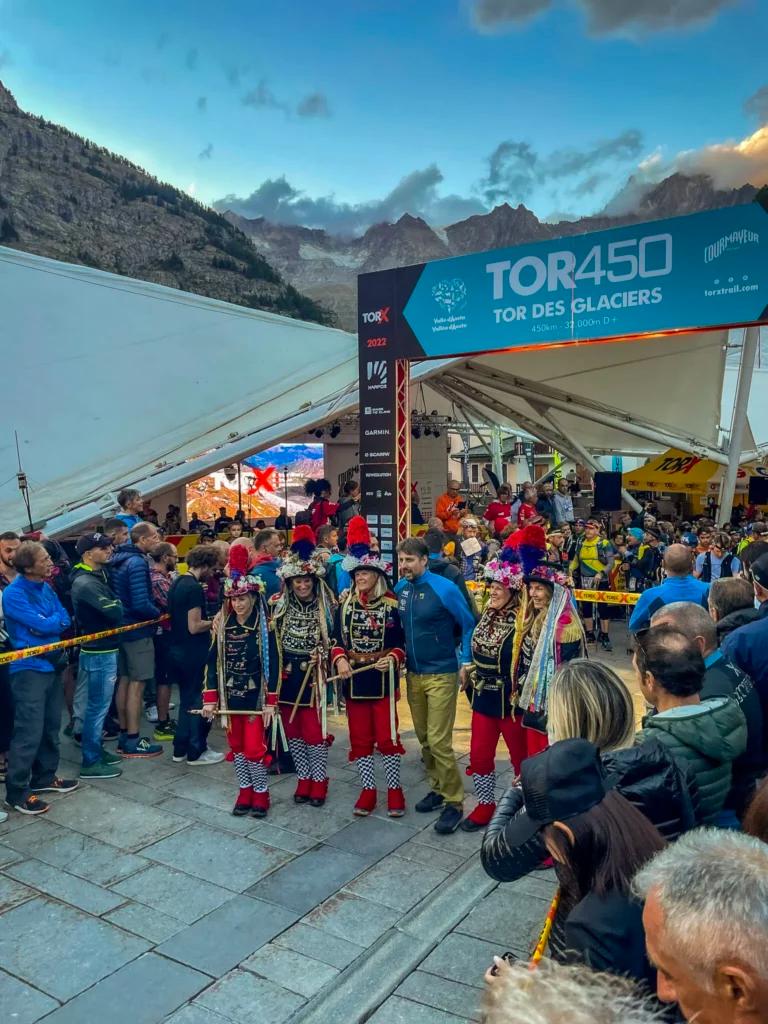
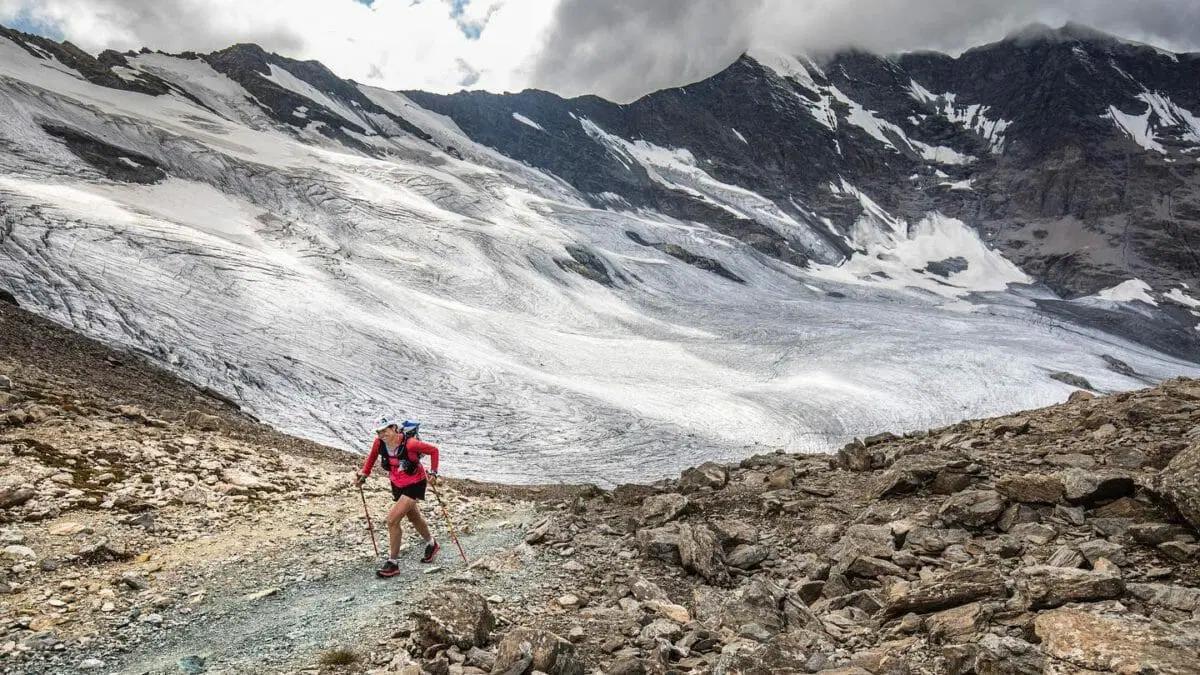
The Women of Tor des Glaciers
The Tor des Glaciers is the longer, more challenging sibling of the already colossal Tor des Géants in the Italian Alps. At 450 kilometers (280 miles) and 32,000 meters (104,987 feet) of cumulative altitude gain, the Tor des Glaciers is the beast that beasts are scared of.
Of the three editions of Glaciers, there have been 124 finishers out of 356 starters. (A few participants ran and finished more than once.) And of those 124 finishers, 9 of them have been women. In an ideal world, we’d hope to see more women in those numbers, but as it is, we want to celebrate these badass women.
So who are these extraordinary women and what have their experiences been like?
To start, here is Stephanie Case in her own voice, sharing her experience running Tor des Glaciers. I interviewed Steph in Courmayeur in September, 2022, while watching both Tor des Géants and Tor des Glaciers finishers come across the finish line. Case, who runs for The North Face, splits her time between Chamonix, France and the Middle East, where she works as a Human Rights Lawyer for the United Nations. She is also the founder of the international nonprofit, Free to Run. In 2021, Stephanie Case ran Tor des Glaciers, coming in third overall and first for women.
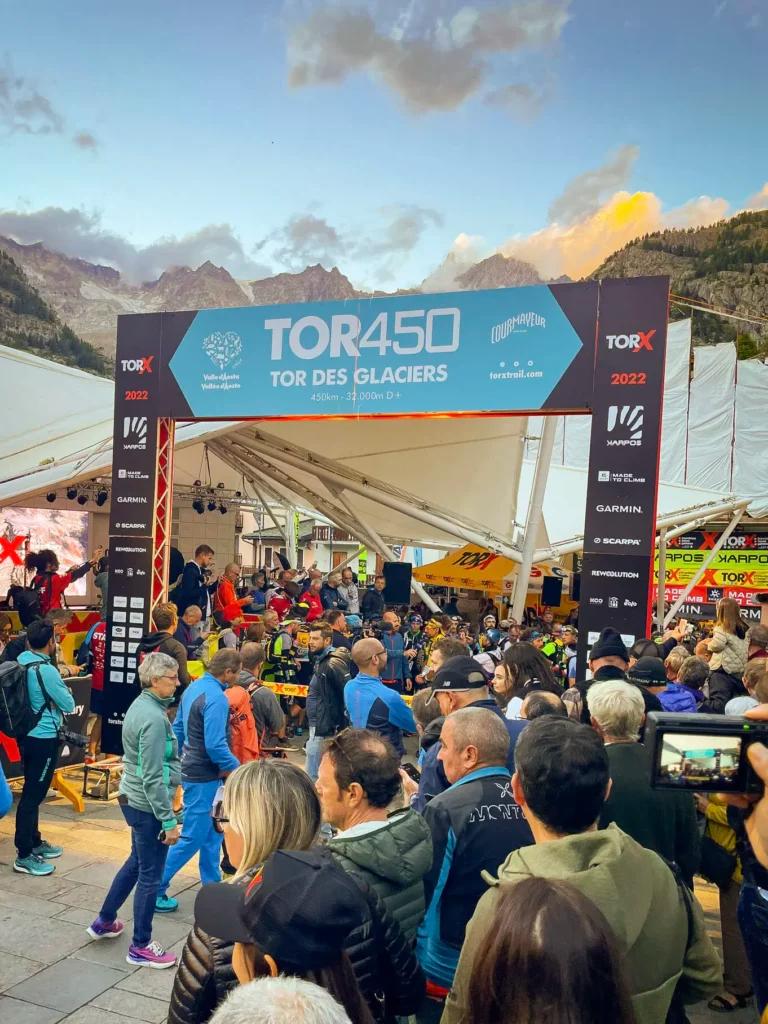
Stephanie Case on Running Tor des Glaciers
The one task I had in that race was to keep moving, above anything else. If you’re hysterically crying – which I was at some points of the race – then you’re just running while hysterically crying. If you’re in pain but nothing’s broken and you can keep moving, then it’s fine – you just keep moving in pain. The race requires an acceptance, or a surrender of sorts, to an extremely high level of discomfort, but once you cross that threshold, it really is quite simple.
There was no point in the race where I thought about dropping out. When you have to run for a week, you can’t think about it like a race. I had to just reorient my thinking and accept that this is my life. I’m running constantly and this is just what I do for life now. There’s no finish. There is no “race”. This is just how life is.
I didn’t even have my watch clocking the kilometers. I wore a watch only so I could see what day it was and determine whether I was heading towards nighttime or not.
I was only able to remind myself that it would end when I got to 15 to 20 kilometers before the finish. At that point, I was really having trouble staying awake, so I decided I would just bite down on my lip as hard as possible to stay awake. I had tried everything else – singing, talking, listening to podcasts, eating constantly – and I was out of tricks. Nothing was working. So in my sleep deprived state, I thought it would be a smart idea to bite down on my lip until I drew a little bit of blood, and that would keep me awake– because that was the kind of pain that might keep me awake but wouldn’t affect my running. I bit down really hard and all it did was give me a fat lip and didn’t keep me awake. That’s when I reminded myself that it was a race and if I just moved a little faster, it would soon be over. It seems ridiculous now to look back on it, but I honestly thought I was making a brilliant move at the time. It was right up there with the tactic I tried about halfway through the race to run with one eye closed, thinking that I was allowing the other eye to “sleep” (hint: I wasn’t).
The Donkey Attack
The most challenging part? Getting attacked by a donkey!
It happened around the 200 kilometer mark, when I was coming up to Dortoir Retempio. There was a donkey on the path and it was kind of walking with me and nudging me a bit. After five or ten minutes, it body slammed me and knocked me to the ground. I was face-down on the ground and it got on top of me. I felt the weight of the entire donkey on top of me. I was terrified. It was really awful.
It went from being a race to suddenly actually worrying that I was going to be suffocated to death by a donkey.
I was screaming at the top of my lungs and hysterically sobbing. I was in full panic mode.
Luckily, there was someone who was filming me coming up to the refuge, so she dropped the camera, ran over, jumped on top of the donkey and punched it in the head until it got off me. But the donkey broke my pole, and my thigh and arm were bruised. It had been biting my head and my neck, and kicking me in the back.
To try to do another 250km, after that kind of experience, was not what I wanted to do. It was really hard to get my head back in the game and head back up the mountain (not to mention continue running alone through the mountains and into the night!).
I got another pole when I got into Donnas, but I was quite traumatized by the whole event. After that experience, I just didn’t trust that I was going to be fine anymore. It really put me on edge.
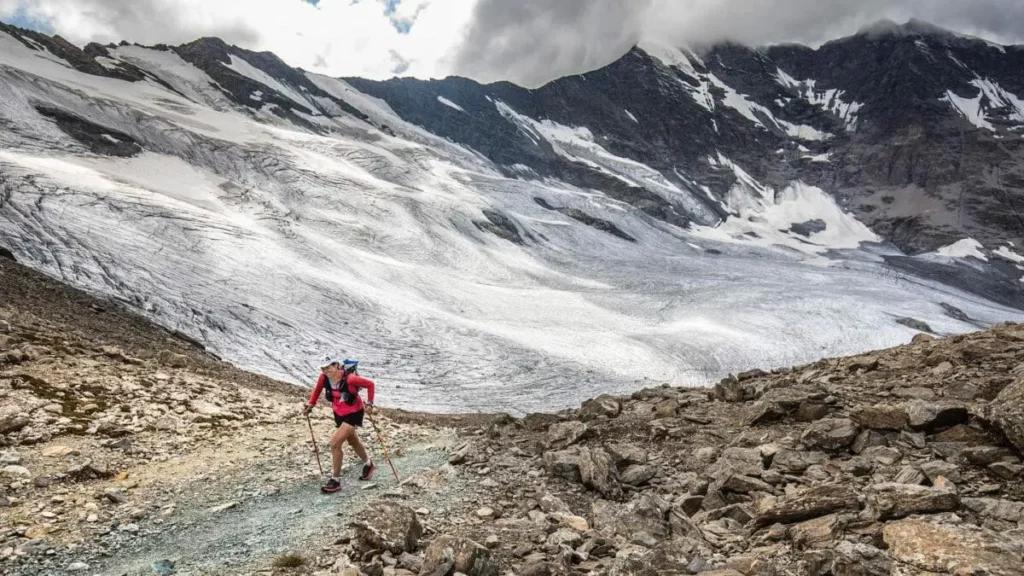
Highlights: Support of Friends and Descending Mont Gelé
I would not have gotten through Tor des Glaciers without the support of my friends, who were crewing me. Some of my best moments were shared with them. After one of the nights, I was coming up to Rifugio Duca degli Abruzzi and it had been raining heavily all night. I was wearing my rain pants– which I almost never wear– my rain top, and a ton of clothes to try to stay warm. I showed up to the refuge completely soaked. My friend Corrado, who had met me at 2am at the previous refuge, had then driven along windy roads and hiked up in the night in the rain to get to this refuge to wait for me. I thought, if my friends are putting in this kind of effort to see me through the race, then I have to keep going. The refuge owners gave me some takeaway lasagna, which I put in my backpack. I had a hot drink, dried off for a few minutes and headed out again, just as the sun came out very briefly. It was a much-needed boost.
While most of my good memories involve times at the refuges with friends, I did have some pretty special moments out there on the trail by myself. Before the race, I had labeled around five spots on the course as “danger spots”, just based on how tricky I had found them in training and the probability of injuring myself. The last “danger spot” was Mont Gele, and the knowledge of having to tackle this near the end of the race was hanging over my head. The climb was brutal and long – I was bobbing and weaving quite a bit, and couldn’t keep my eyes on the path – and the descent in the dark was far from straightforward. When the sun finally started to come up, I realized that I had navigated my way through the tough bits and there were no more danger spots ahead. I had nothing else left to worry about. I thought, “Okay, all I have to do now is just run to the finish line.”
It felt pretty amazing to suddenly realize I was still running and functional after so many days of running (five at that point?). In that moment, I didn’t really feel much pain. Of course that didn’t last – I think 20 minutes later, I was in excruciating pain – but for the moment the euphoria was amazing.
Homemade Pizza in the Middle of the Night: The Essence of Tor des Glaciers
When I was coming up to Rifugio Crête Sèche, Jose, Corrado’s wife and another dear friend, was waiting in the refuge for me. She’d been there for hours in the middle of the night, waiting up with the refuge owners for me to arrive. The owners asked Jose if there was anything in particular that I liked. She said pizza, so they spent their time making homemade pizza for me at 2000m after midnight.
When I finally burst through the refuge doors, I was absolutely freezing and shivering a ton, so they turned up the heat, heating the whole place. I scarfed down the pizza and they took me upstairs to nap, covering me with four blankets and putting a heater beside my bed. Jose sat with me to make sure I fell asleep (which I did in a matter of seconds, but it always felt like an eternity).
I woke up 20 minutes later and discovered I’d blown-up like a boiled tomato. I was so swollen and hot, and my wristband was cutting into my skin. Twenty minutes after I had complained about being too cold I was suddenly complaining of overheating. So, the refuge owners immediately opened all the windows and let the cold air come in, letting out all of the heat they had just pumped in. They will do anything you need, as ridiculous as it sounds, just to keep you going.
Similarly, in Rifugio della Balma, I couldn’t stay awake and I was having trouble eating. I asked the people running the refuge for butter and without blinking an eye, they asked me if I wanted it warmed up or cold. “How would you like your butter?” I thought it was pretty sweet. Everything just becomes normal and accepted when you’re out on Tor des Glaciers.
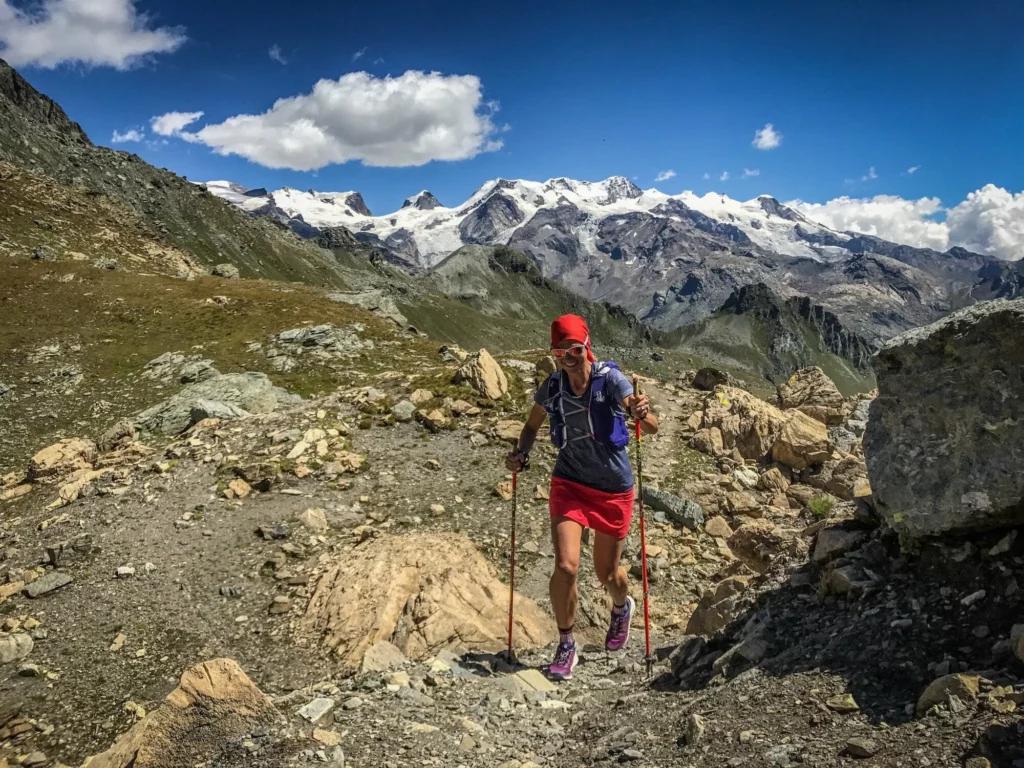
Being a Women in Tor des Glaciers
I was disappointed that there weren’t more women to compete with. At the start line in 2021, there were only three of us. I really wanted them to succeed. I wanted Marina to be running with me or to be beating me. I wanted that female competition to be there and unfortunately it wasn’t. So, I wanted to do something with my race that would prove to other women that it’s totally possible.
I’m still disappointed that there aren’t more women, but at least this year [2022] we had a dozen and we had five women finishers. So it’s getting better.
I think people were surprised to see me so far up in the pack. They weren’t expecting to see a woman third overall.
There’s still a lot of sexism. One example that I did an Instagram post about was a photographer I came across on day two. He was trying to get my attention and said something like, “Hey, sexy lady! Sexiest lady on the mountain!” It was just ridiculous because at that point I think I was in second and I thought, “I’m in second overall, doing one of the most badass things I’ve ever done and this guy is referring to my looks when I’m running?”
Yeah, we still get treated differently.
For the most part though, the reaction was so positive. I’m still getting nice reactions. The common assumption is still that we are weaker, but the strength that women show in trying to do a race like Tor des Glaciers completely defies that.
I don’t want it to be any more exceptional for a woman to be doing Glaciers than it is for a man. But right now, I feel like to get to the start line of Glaciers, it does require something extra from the women. I wish it didn’t, but it does. So I feel more of a bond and more respect for other women in the race.
While Case’s story is extraordinary, she’s not alone as a woman finishing Glaciers — there are seven other women who have their own impressive stories. All of these women are pioneering a path for women to compete in this extreme race. Here are the other women in the Tor des Glaciers hall of fame.
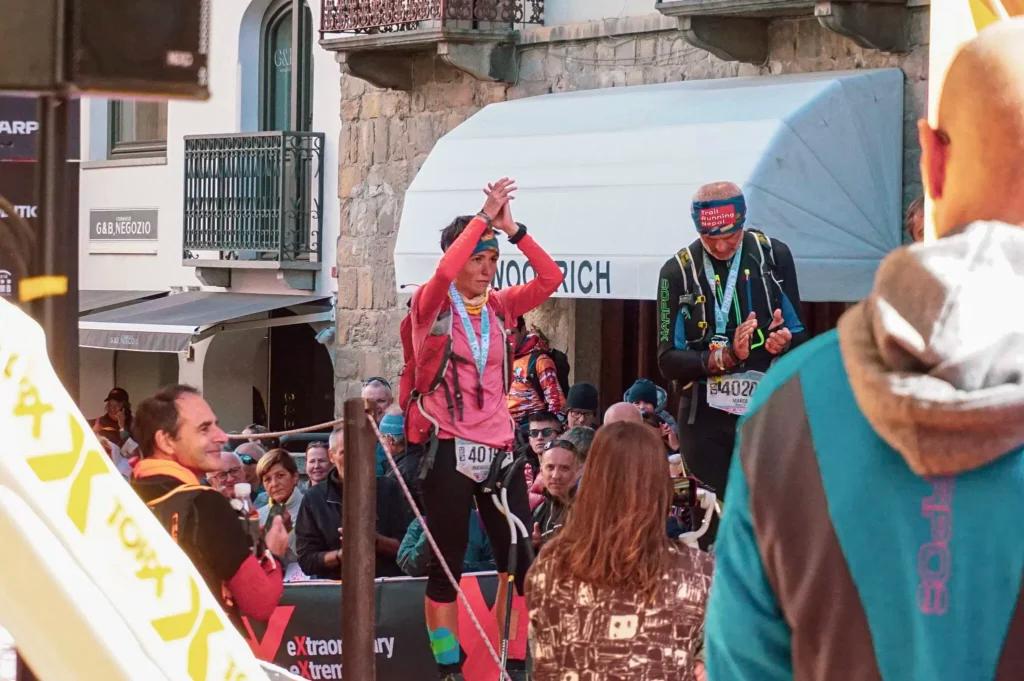
Anouk Baars
Anouk Baars was the first woman to complete the Tor des Glaciers. She finished the 2019 inaugural race with a time of 183 hours 6 minutes. Based in Chamonix, France, Baars is Dutch-Venezuelan, and has two adventurous kids. She is sponsored by Instinct. In 2022, Baars completed the PTL by UTMB® and was part of the first mixed-gender team to finish.
Marina Plavan
Italian Marina Plavan is currently the only woman to complete the Tor des Glaciers twice. First in 2019 and again in 2021, she came in second for women both times. She also ran Glaciers in 2022 and was on track to be the first woman, but took a fall that ended her race less than 40 kilometers from the finish. At the time, she was more than two hours ahead of the woman in second place. According to an interview with Milano Montagna, Plavan began running in 2004 at the age of 43. She is 61, and hasn’t stopped yet! Plavan also completed Tor des Geants a remarkable five times.
Isabelle Ost
Isabelle Ost from Belgium was the first woman in the 2022 race and came in 23rd overall. She crossed the Glaciers finish line with her husband, with whom she ran. Ost also participated in the first edition of Tor des Geants in 2010, coming in fifth for women. Ost is a mother of two and professor at Saint Louis University in Brussels.
Chloé Saint Joly
French Chloé Saint Joly finished as the second woman in 2022. At 34, she’s the youngest woman to have completed Glaciers. She finished in 171 hours 43 minutes.
Nicky Spinks
British mountain runner Nicky Spinks was the third woman in 2022. She’s also a two-time starter of the notoriously hard Barkley Marathon and has been dubbed “Britain’s toughest woman” by media, after her completion of a 116-mile Double Ramsay Round in Scotland. Spinks is also a breast cancer survivor and Inov-8 ambassador.
Guendalina Sibona
Known as Guè Sibona, this Italian was the last person to finish the full Tor des Glaciers course in 2022 before the weather ended the race early for slower participants. She fought through a major Alps snow storm, at one point trudging through 10 centimeters of snow and whiteout conditions. You can read her full account on Sport Mediaset. Sibona is a photographer, writer, and running adventurer. She’s written six books, one of which is about her journey running Tor des Géants in 2019.
Monica Guilera
Guilera was the first of the Tor des Glaciers runners to get cut off by the snowstorm in 2022, when race officials stopped both Tor des Géants and Tor des Glaciers. Her race ended at Hotel Italia, 425 km into the event. Tor officials awarded her a finish, based on their belief that these runners would have finished under the final time barrier if weather conditions had allowed it. From Spain, Guilera is a mother and is a Ferrino running ambassador.
All of these women have accrued monumental accomplishments, and they’ve done more than that, too: they’ve created a space for women in Tor des Glaciers and shown other women that it’s possible to run and finish Tor des Glaciers.
As people say, if you can see it, you can be it. Now, more and more women are demonstrating that there is a place for women in Tor des Glaciers. Hopefully, a greater percentage of the Glaciers champions will be women in the future.
